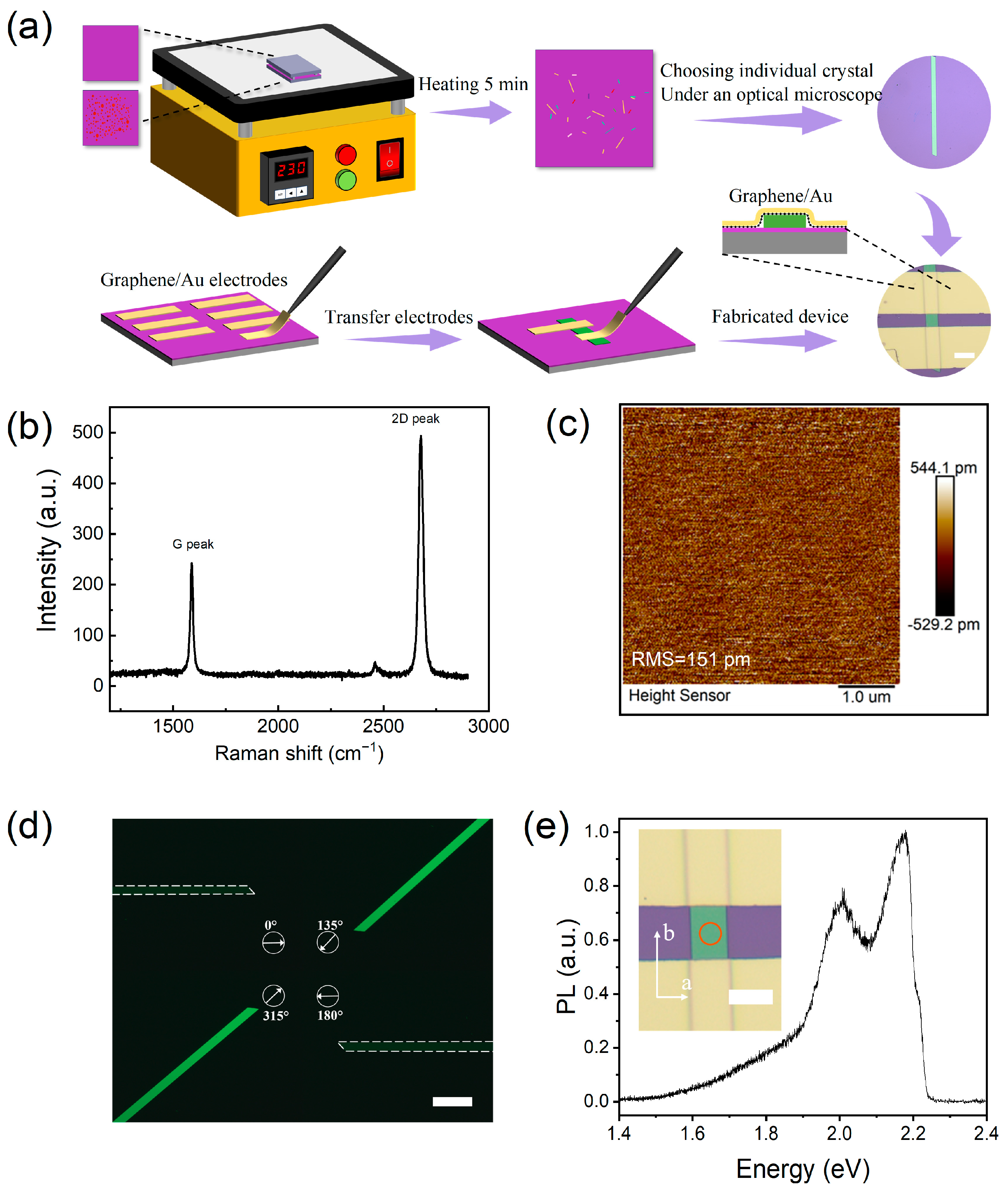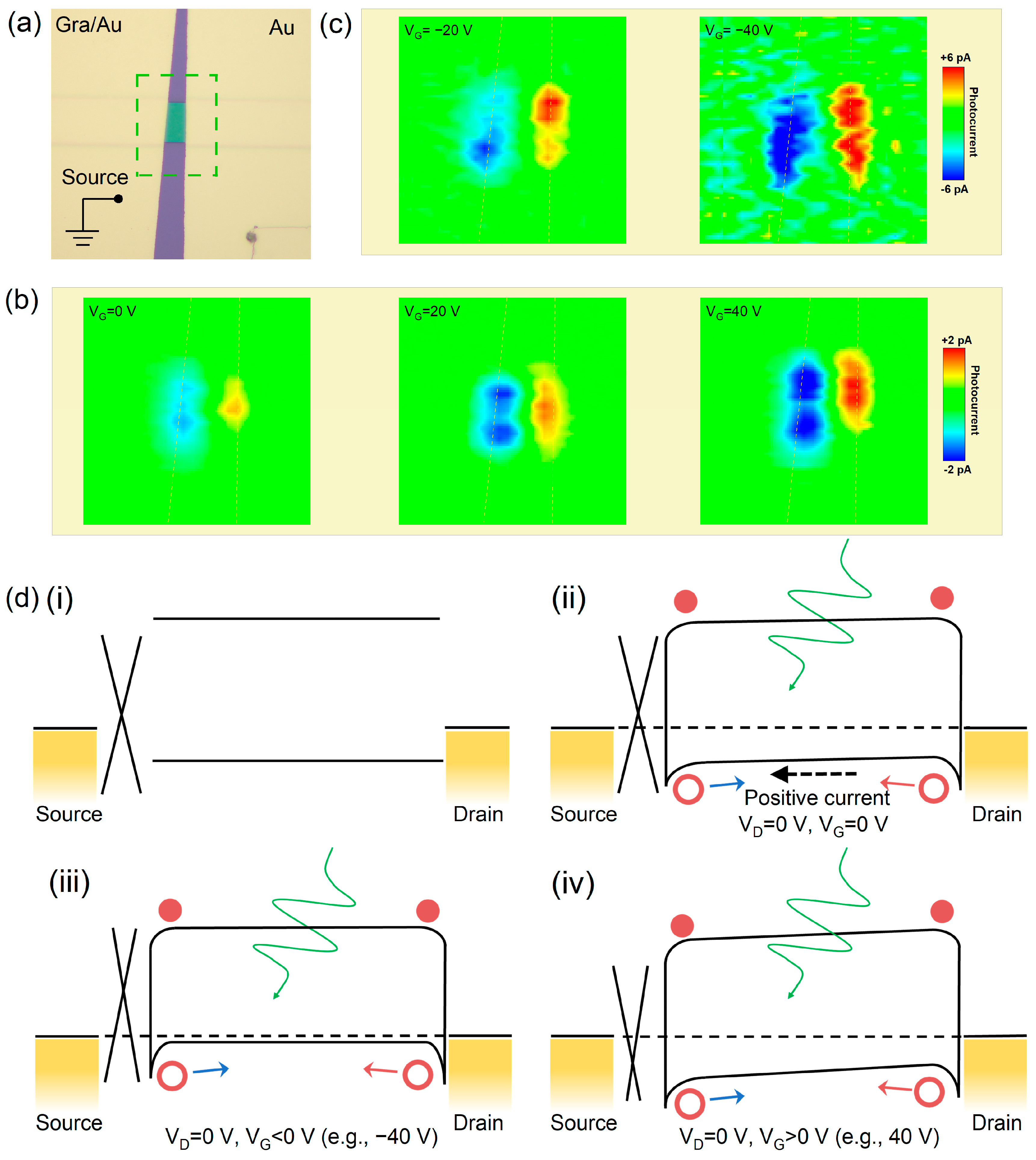Asymmetric Schottky Barrier in Rubrene Transistor via Monolayer Graphene Insertion toward Self-Powered Imaging
Abstract
:1. Introduction
2. Materials and Methods
2.1. Crystal and Device Fabrication
2.2. Materials and Device Characterizations
3. Results and Discussion
4. Conclusions
Supplementary Materials
Author Contributions
Funding
Institutional Review Board Statement
Informed Consent Statement
Data Availability Statement
Conflicts of Interest
References
- Wang, C.; Dong, H.; Jiang, L.; Hu, W. Organic Semiconductor Crystals. Chem. Soc. Rev. 2018, 47, 422–500. [Google Scholar] [CrossRef] [PubMed]
- Chen, Z.; Obaid, S.N.; Lu, L. Recent Advances in Organic Optoelectronic Devices for Biomedical Applications. Opt. Mater. Express 2019, 9, 3843–3856. [Google Scholar] [CrossRef]
- Tvingstedt, K.; Dal Zilio, S.; Inganaes, O.; Tormen, M. Trapping Light with Micro Lenses in Thin Film Organic Photovoltaic Cells. Opt. Express 2008, 16, 21608–21615. [Google Scholar] [CrossRef] [PubMed]
- Wang, R.; Wang, T.; Kang, Z.; Zhang, H.; Yu, R.; Ji, W. Efficient Flexible Quantum-Dot Light-Emitting Diodes with Unipolar Charge Injection. Opt. Express 2022, 30, 15747–15756. [Google Scholar] [CrossRef]
- Ren, Z.; Yang, J.; Qi, D.; Sonar, P.; Liu, L.; Lou, Z.; Shen, G.; Wei, Z. Flexible Sensors Based on Organic-Inorganic Hybrid Materials. Adv. Mater. Technol. 2021, 6, 2000889. [Google Scholar] [CrossRef]
- Wu, L.; Fukuda, K.; Yokota, T.; Someya, T. A highly responsive organic image sensor based on a two-terminal organic photodetector with photomultiplication. Adv. Mater. 2019, 31, 1903687. [Google Scholar] [CrossRef] [PubMed]
- Zhu, D.; Jiang, W.; Ma, Z.; Feng, J.; Zhan, X.; Lu, C.; Liu, J.; Hu, Y.; Wang, D.; Zhao, S. Organic Donor-Acceptor Heterojunctions for High Performance Circularly Polarized Light Detection. Nat. Commun. 2022, 13, 3454. [Google Scholar] [CrossRef]
- Wu, D.; Guo, J.; Du, J.; Xia, C.; Zeng, L.; Tian, Y.; Shi, Z.; Tian, Y.; Li, X.J.; Tsang, Y.H.; et al. Highly Polarization-Sensitive, Broadband, Self-Powered Photodetector Based on Graphene/PdSe2/Germanium Heterojunction. ACS Nano 2019, 13, 9907–9917. [Google Scholar] [CrossRef]
- Zhang, C.; Xu, C.; Chen, C.; Cheng, J.; Zhang, H.; Ni, F.; Wang, X.; Zou, G.; Qiu, L. Optically Programmable Circularly Polarized Photodetector. ACS Nano 2022, 16, 12452–12461. [Google Scholar] [CrossRef]
- Dursun, I.; Guzelturk, B. Exciton Diffusion Exceeding 1 μm: Run, Exciton, Run. Light Sci. Appl. 2021, 10, 39. [Google Scholar] [CrossRef]
- Diao, L.; Daniel Frisbie, C.; Schroepfer, D.D.; Paul Ruden, P. Electrical Characterization of Metal/Pentacene Contacts. J. Appl. Phys. 2007, 101, 014510. [Google Scholar] [CrossRef]
- Gundlach, D.J.; Zhou, L.; Nichols, J.A.; Jackson, T.N.; Necliudov, P.V.; Shur, M.S. An Experimental Study of Contact Effects in Organic Thin Film Transistors. J. Appl. Phys. 2006, 100, 024509. [Google Scholar] [CrossRef]
- Zeng, J.; He, D.; Qiao, J.; Li, Y.; Sun, L.; Li, W.; Xie, J.; Gao, S.; Pan, L.; Wang, P.; et al. Ultralow Contact Resistance in Organic Transistors via Orbital Hybridization. Nat. Commun. 2023, 14, 324. [Google Scholar] [CrossRef]
- Schweicher, G.; Garbay, G.; Jouclas, R.; Vibert, F.; Devaux, F.; Geerts, Y.H. Molecular Semiconductors for Logic Operations: Dead-End or Bright Future. Adv. Mater. 2020, 32, 1905909. [Google Scholar] [CrossRef]
- Liu, Y.; Weiss, N.O.; Duan, X.; Cheng, H.-C.; Huang, Y.; Duan, X. Van Der Waals Heterostructures and Devices. Nat. Rev. Mater. 2016, 1, 16042. [Google Scholar] [CrossRef]
- Liu, L.; Kong, L.; Li, Q.; He, C.; Ren, L.; Tao, Q.; Yang, X.; Lin, J.; Zhao, B.; Li, Z.; et al. Transferred van Der Waals Metal Electrodes for Sub-1-Nm MoS2 Vertical Transistors. Nat. Electron. 2021, 4, 342–347. [Google Scholar] [CrossRef]
- Liu, Y.; Huang, Y.; Duan, X. Van Der Waals Integration before and beyond Two-Dimensional Materials. Nature 2019, 567, 323–333. [Google Scholar] [CrossRef]
- Wang, X.; Pan, L.; Yang, J.; Li, B.; Liu, Y.; Wei, Z. Direct Synthesis and Enhanced Rectification of Alloy-to-Alloy 2D Type-II MoS2(1-x)Se2x/SnS2(1-y)Se2y Heterostructures. Adv. Mater. 2021, 33, 2006908. [Google Scholar] [CrossRef]
- Meng, Q.; Chen, F.; Xu, Y.; Cheng, S.; Yang, W.; Yao, D.; Yi, Z. Tunable Terahertz Double Plasmon Induced-Transpare based on monolayer patterned graphene structure. Photonic Nanostruct. 2023, 54, 101132. [Google Scholar] [CrossRef]
- Silva, B.; Rodrigues, J.; Sompalle, B.; Liao, C.-D.; Nicoara, N.; Borme, J.; Cerqueira, F.; Claro, M.; Sadewasser, S.; Alpuim, P.; et al. Efficient ReSe2 Photodetectors with CVD Single-Crystal Graphene Contacts. Nanomaterials 2021, 11, 1650. [Google Scholar] [CrossRef]
- Wang, X.; Zhi, L.; Muellen, K. Transparent, Conductive Graphene Electrodes for Dye-Sensitized Solar Cells. Nano Lett. 2008, 8, 323–327. [Google Scholar] [CrossRef]
- Meng, Q.; Chen, F.; Xu, Y.; Cheng, S.; Yang, W.; Yao, D.; Yi, Z. Multi-Frequency Polarization and Electro-Optical Modulator Based on Triple Plasmon- Induced Transparency in Monolayer Graphene Metamaterials. Diam. Relat. Mater. 2023, 138, 110216. [Google Scholar] [CrossRef]
- Chen, Y.; Lee, B.; Fu, D.; Podzorov, V. The Origin of a 650 nm Photoluminescence Band in Rubrene. Adv. Mater. 2011, 23, 5370–5375. [Google Scholar] [CrossRef] [PubMed]
- Du, Q.; Qin, S.; Wang, Z.; Gan, Y.; Zhang, Y.; Fan, L.; Liu, Y.; Li, S.; Dong, R.; Liu, C.; et al. Highly Sensitive and Ultrafast Organic Phototransistor Based on Rubrene Single Crystals. ACS Appl. Mater. Interfaces 2021, 13, 57735–57742. [Google Scholar] [CrossRef] [PubMed]
- Pei, K.; Wang, F.; Han, W.; Yang, S.; Liu, K.; Liu, K.; Li, H.; Zhai, T. Suppression of Persistent Photoconductivity of Rubrene Crystals using Gate-Tunable Rubrene/Bi2Se3 Diodes with Photoinduced Negative Differential Resistance. Small 2020, 16, 2002312. [Google Scholar] [CrossRef] [PubMed]
- Ye, X.; Liu, Y.; Han, Q.; Ge, C.; Cui, S.; Zhang, L.; Zheng, X.; Liu, G.; Liu, J.; Liu, D.; et al. Microspacing In-Air Sublimation Growth of Organic Crystals. Chem. Mater. 2018, 30, 412–420. [Google Scholar] [CrossRef]
- Gan, Y.; Qin, S.; Du, Q.; Zhang, Y.; Zhao, J.; Li, M.; Wang, A.; Liu, Y.; Li, S.; Dong, R.; et al. Ultrafast and Sensitive Self-Powered Photodetector Based on Graphene/Pentacene Single Crystal Heterostructure with Weak Light Detection Capacity. Adv. Sci. 2022, 9, 2204332. [Google Scholar] [CrossRef] [PubMed]
- Ye, X.; Liu, Y.; Guo, Q.; Han, Q.; Ge, C.; Cui, S.; Zhang, L.; Tao, X. 1D Versus 2D Cocrystals Growth via Microspacing In-Air Sublimation. Nat. Commun. 2019, 10, 761. [Google Scholar] [CrossRef]
- Wang, C.; Dong, H.; Hu, W.; Liu, Y.; Zhu, D. Semiconducting π-Conjugated Systems in Field-Effect Transistors: A Material Odyssey of Organic Electronics. Chem. Rev. 2012, 112, 2208–2267. [Google Scholar] [CrossRef] [PubMed]
- Zhao, J.; Zhu, Q.; Li, X.; Liu, Y.; Li, S.; Wang, W.; Wang, F.; Qin, S. Self-Powered Organic Phototransistors with Asymmetrical van Der Waals Stacking for Flexible Image Sensors. ACS Photonics 2023, 10, 2955–2963. [Google Scholar] [CrossRef]
- Irkhin, P.; Ryasnyanskiy, A.; Koehler, M.; Biaggio, I. Absorption and Photoluminescence Spectroscopy of Rubrene Single Crystals. Phys. Rev. B 2012, 86, 085143. [Google Scholar] [CrossRef]
- Lee, S.; Tang, A.; Aloni, S.; Wong, H.-S.P. Statistical Study on the Schottky Barrier Reduction of Tunneling Contacts to CVD Synthesized MoS2. Nano Lett. 2016, 16, 276–281. [Google Scholar] [CrossRef]
- Chen, J.; Calvet, L.C.; Reed, M.A.; Carr, D.W.; Grubisha, D.S.; Bennett, D.W. Electronic Transport through Metal-1,4-Phenylene Diisocyanide–Metal Junctions. Chem. Phys. Lett. 1999, 313, 741–748. [Google Scholar] [CrossRef]
- Kim, Y.; Chung, S.; Cho, K.; Harkin, D.; Hwang, W.-T.; Yoo, D.; Kim, J.-K.; Lee, W.; Song, Y.; Ahn, H.; et al. Enhanced Charge Injection Properties of Organic Field-Effect Transistor by Molecular Implantation Doping. Adv. Mater. 2019, 31, 1806697. [Google Scholar] [CrossRef] [PubMed]
- Castro Neto, A.H.; Guinea, F.; Peres, N.M.R.; Novoselov, K.S.; Geim, A.K. The Electronic Properties of Graphene. Rev. Mod. Phys. 2009, 81, 109–162. [Google Scholar] [CrossRef]




Disclaimer/Publisher’s Note: The statements, opinions and data contained in all publications are solely those of the individual author(s) and contributor(s) and not of MDPI and/or the editor(s). MDPI and/or the editor(s) disclaim responsibility for any injury to people or property resulting from any ideas, methods, instructions or products referred to in the content. |
© 2023 by the authors. Licensee MDPI, Basel, Switzerland. This article is an open access article distributed under the terms and conditions of the Creative Commons Attribution (CC BY) license (https://creativecommons.org/licenses/by/4.0/).
Share and Cite
Liu, Q.; Zheng, X.; Li, M.; Du, Q.; Zhu, C.; Wang, W.; Qin, S. Asymmetric Schottky Barrier in Rubrene Transistor via Monolayer Graphene Insertion toward Self-Powered Imaging. Materials 2023, 16, 7364. https://doi.org/10.3390/ma16237364
Liu Q, Zheng X, Li M, Du Q, Zhu C, Wang W, Qin S. Asymmetric Schottky Barrier in Rubrene Transistor via Monolayer Graphene Insertion toward Self-Powered Imaging. Materials. 2023; 16(23):7364. https://doi.org/10.3390/ma16237364
Chicago/Turabian StyleLiu, Qing, Xialian Zheng, Mengru Li, Qianqian Du, Chunhui Zhu, Wenjun Wang, and Shuchao Qin. 2023. "Asymmetric Schottky Barrier in Rubrene Transistor via Monolayer Graphene Insertion toward Self-Powered Imaging" Materials 16, no. 23: 7364. https://doi.org/10.3390/ma16237364
APA StyleLiu, Q., Zheng, X., Li, M., Du, Q., Zhu, C., Wang, W., & Qin, S. (2023). Asymmetric Schottky Barrier in Rubrene Transistor via Monolayer Graphene Insertion toward Self-Powered Imaging. Materials, 16(23), 7364. https://doi.org/10.3390/ma16237364





